nyb.gif) image by Clay Moss, 13 Nov 2008
image by Clay Moss, 13 Nov 2008
Last modified: 2018-09-12 by bruce berry
Keywords: malawi | nyasaland |
Links: FOTW homepage |
search |
disclaimer and copyright |
write us |
mirrors
See also:
The territory was defined as British Central Africa in 1890. When the first explorers arrived in what
is now Malawi, they were told by the local inhabitants that the big lake was called 'Nyasa'. So the lake was christened Lake Nyasa
- which it will not surprise you to learn means '
Stuart Notholt, 22 Nov 1995
A British Protectorate was declared over the 'Nyasaland Districts' (i.e. present day Malawi) on 15 May 1891. In 1893 the territory was renamed the British Central Africa Protectorate. By the Nyasaland Order in Council, dated 06 July 1907, the name of the territory was changed again, this time to the Nyasaland Protectorate and Legislative and Executive Councils were established and a Governor was appointed in the place of the former Commissioner. The first Legislative Council met on 04 September 1907.
The possibility of associating Nyasaland with
one or more of its neighbours had been considered at
various times between the two World Wars. On 07 September 1953 the Federation of Rhodesia and Nyasaland
(also known as the Central African Federation)
consisting of Southern Rhodesia, Northern Rhodesia and Nyasaland, came into
being. On 31 December 1963 the Federation was dissolved with each
participating state once again becoming single political entities. On 06
July 1964 Nyasaland became the fully independent state of Malawi within the British
Commonwealth. On the second anniversary of independence, Malawi became a
republic, remaining a member of the Commonwealth.
Bruce Berry, 24 Nov 1995
nyb.gif) image by Clay Moss, 13 Nov 2008
image by Clay Moss, 13 Nov 2008
On 11 May 1914 a formal grant of arms to Nyasaland
was made. This comprised a leopard with a rising sun reflected against a black
background. Coffee, having not lived up to its expectations as the major crop
in the colony, was thus dropped as the main symbol of the territory.
Following this grant of Arms, a new flag bearing the leopard and sun was
adopted as the flag of the territory. The Nyasaland Blue Ensign contained the
arms in the fly (without roundel) and was used until 23 October 1953 when the
territory was incorporated into the Federation of
Rhodesia and Nyasaland and the Federation flag was adopted.
Following the break-up of the Federation on 31 December 1963, Nyasaland
received its independence as the self-governing state of Malawi on 06
July 1964 and adopted a new flag without any colonial connotations.
Bruce Berry, 14 Oct 1997
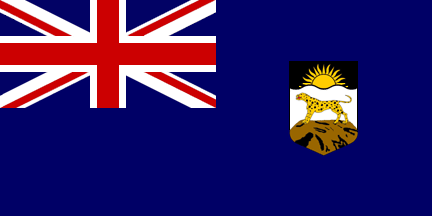 image by Clay
Moss, 13 Nov 2008
image by Clay
Moss, 13 Nov 2008
The badge on Nyasaland Blue Ensigns, made between 1914 and the end of 1919, was set on a white circle. I imagine that existing ensigns continued to be while stocks lasted, but any ensigns made after 1919 had no white circle.
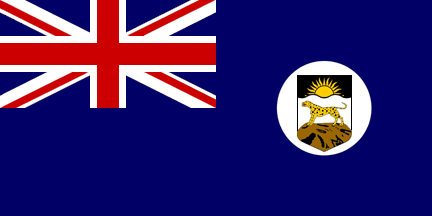 image by Clay Moss,
13 Nov 2008
image by Clay Moss,
13 Nov 2008
In 1919 the Colonial Office sent a circular dispatch asking Governors for
details of the flags in use, particularly with regard to whether or not the
badge on ensigns appeared on a white circle. In a letter dated 28 April 1919
the Nyasaland Governor's Office wrote, "Coat of Arms, which is the badge,
is in a white circle, but it would be better without, since the field of the
escutcheon is white (argent)". On 12 December 1919 the Crown Agents were
instructed to omit the white circle from the Nyasaland Blue Ensign [National
Archives (PRO) ADM 116/1847B].
The eighth amendment (1925) to the 1916 edition of the Admiralty Flag Book
included a complete list of all colonial and departmental badges, and whether
or not they were to appear on a white circle. The entry for Nyasaland
was "On Union Flag as shown, with garland; On Blue Ensign, no white
circle".
Illustrations of the badge usually show a more rectangular straight-sided
shield, and have a darker shade of yellow for the sun, and the coat of the
leopard.
David Prothero, 05 Aug 2004
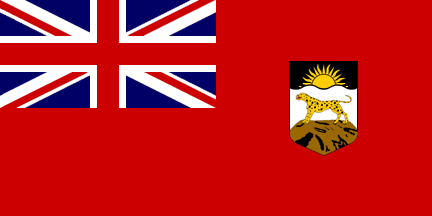 image by Clay Moss, 13 Nov 2008
image by Clay Moss, 13 Nov 2008
Nyasaland Red Ensigns appear to have been used, although unofficially.
These flags had the badge placed directly in the fly without the white disc and
were probably used by vessels on Lake Nyasa (now Lake Malawi).
Clay Moss, 13 Nov 2008
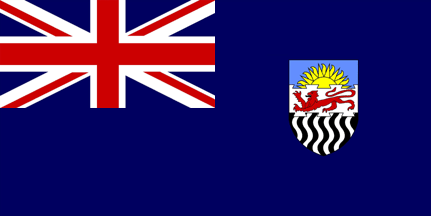 image by Clay Moss, 10 Sept 2005
image by Clay Moss, 10 Sept 2005 In 1953
Nyasaland, along with Northern and Southern Rhodesia, became part of the Federation
of Rhodesia and Nyasaland and the Federal blue ensign was flown in the
Colony, alongside the Union Jack.
Bruce Berry, 16 Feb 1998
The flag of the Federation was a British blue ensign with the shield from
the Federation coat of arms (granted by Royal Warrant on 22 July 1954) in the
fly, namely:
"Per fess Azure and Sable in Chief a Sun rising Or and in base six palets wavy Argent overall a fesse
dovetailed counter-dovetailed of the last thereon a Lion passant Gules".
The shield was an amalgam of those of the participating territories. The
rising sun in gold came from the shield of Nyasaland, the red lion from that of
Southern Rhodesia and the six vertical black and white wavy 'pallets'
representing the Victoria Falls came from that of Northern
Rhodesia.
According to H. Cresham Carr, Flags of the World (1961), this ensign differed from most others on the colonial pattern in being in proportion of 3:5. However, in practice actual flags were manufactured in the usual British ensign tradition of 1:2.
Largely as a result of the political pressure of the emerging African
nationalistic aspirations, the Federation was dissolved at midnight on 31
December 1963, and the three territories went their separate ways.
Nyasaland became the independent state of Malawi on 06 July 1964 and Northern
Rhodesia became the independent state of Zambia on 23 October 1964.
Southern Rhodesia remained ostensibly a British colony until its Unilateral
Declaration of Independence on 11 November 1965.
Bruce Berry, 28 June 2005
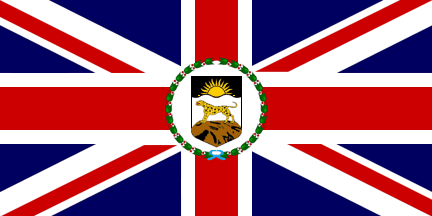 image by Clay Moss, 13
Nov 2008
image by Clay Moss, 13
Nov 2008
The flag used by the Governor of the Protectorate of Nyasaland was a
British Union Flag charged in the centre, on a white roundel, with the Arms
granted to the Protectorate on 11 May 1914, namely: "Argent, on a Rock
issuant from the base a Leopard statant proper, on a
Chief wavy sable the Rising Sun Or".
In common with other flags used by British Colonial Governors, the Arms were
within a green garland of laurel.
This flag continued to be used by the Governor of Nyasaland when Nyasaland
became on of the constituent territories of the Federation of Rhodesia and Nyasaland between
1953 and 1963 and ceased to be used once Nyasaland gained independence on 06
July 1964 as the self-governing state of Malawi.
Source: SAVA Journal SJ: 3/94, The Union Jack
over Southern and Central Africa, 1965-1994 by
FG Brownell [brl94].
Bruce Berry, 17 Jan 2003
![[Governor-General's flag]](../images/m/mw_gg1.gif) image by Željko Heimer, 22 Mar 2003
image by Željko Heimer, 22 Mar 2003
I have no detailed information on this flag and if it was ever in official
use. The above illustration is from 'Flags of The World' by Bill Yenne, published by Bison Books (1993) [ynn93].
Željko Heimer,
22 Mar 2003